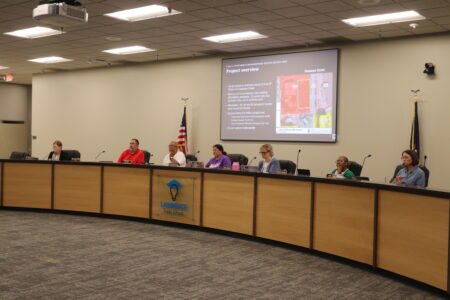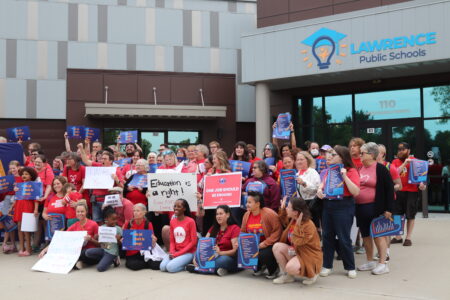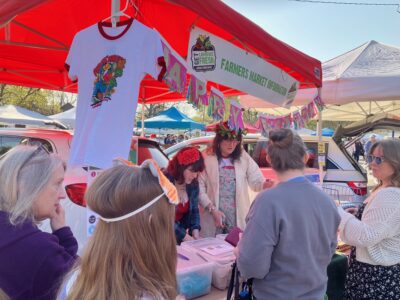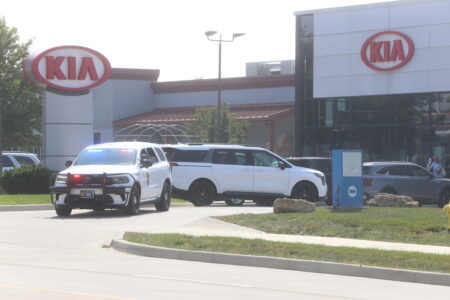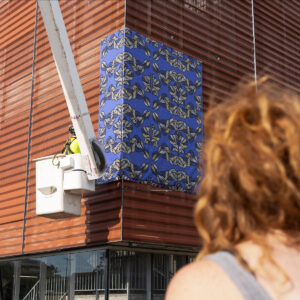Historians in Kansas highlight their effort to restore Civil War flags and the human stories behind them
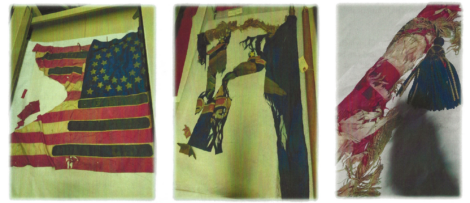
photo by: Contributed by Kansas Historical Society
Images of some of the 19th Century flags in the Kansas Historical Society's collection that have degraded over time. Tom Schmidt is one of the people spearheading a program that would help raise funds and awareness of the need to restore the flags to help preserve Kansas history.
When he works to help preserve old and tattered battle flags from the Civil War, Tom Schmidt is doing what a Union soldier, in his final moments, exhorted his fellow Kansans to do: “Keep the flag to the front.”
Schmidt, a Civil War reenactor from Eudora, has been hard at work with the Kansas Historical Society trying to re-energize a state program that helps restore historic flags. It’s important to do this, he said, because these flags are full of stories.
“The flags can tell a very human story,” Schmidt said. “They were not to fall into enemy hands. They were representative of the unit, their pride and community.”
One of those stories is that of 26-year-old Charles Robhol, the head of the color guard for the Eighth Kansas Infantry regiment.
The Eighth was one of the few Kansas regiments to battle east of the Mississippi River, and in 1863, Robhol was the man responsible for carrying its flag into the fray at the Battle of Chickamauga in northwest Georgia.
Flag-bearers back then were some of the most important men in the army, Schmidt said. There were no radios, so flags were the clearest way to communicate instructions amid the noise of battle. But the flag-bearers also had to stand six paces in front of the rest of the troops to be seen and to lead them, which meant they were always a target for the enemy’s guns.
So it was that Robhol was mortally wounded at Chickamauga. Other members of the guard came to his aid, but he refused their help. He told his men, “My life is nothing. Keep the flag to the front.”
• • •
Those words weren’t forgotten by the men of the Eighth, Schmidt said. They became the unofficial motto of the regiment. After the battle was over, only two men in the color guard were unhurt, and one of the members of the unit turned down a promotion “because he would not part with the colors.”
Robhol’s story was being told decades after the battle. Schmidt said we know this story because Gov. John Martin, a former colonel in the Eighth, told it in a speech at Fort Scott in 1888.
But as the decades went by, Kansans didn’t do as good a job of keeping the Civil War flags to the front.
The Kansas Historical Society holds about 70 flags from the 19th century, including 37 Civil War flags. For years, the collection of battle flags sat at the state Capitol in Topeka, but Schmidt said they were moved in 1914 to the Memorial Building in Topeka after it was built to celebrate the Grand Army of the Republic.
There was some fanfare initially about moving the flags to the building, but they were not well taken care of. The proper care for old flags is to lay them flat, but people didn’t understand that at the time. Schmidt said some of the flags were rolled up after the 1914 ceremony and never touched again.
Over more than 100 years, the flags have deteriorated. Some were tattered from battle and already in bad shape even before they were put in storage, Schmidt said.
“Some of them are not too bad, but others are in bad shape,” Schmidt said.
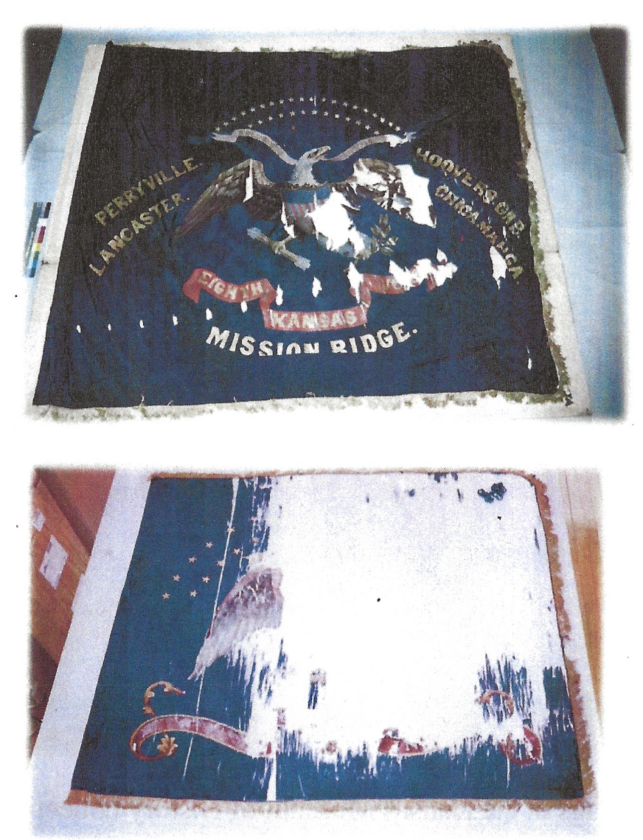
photo by: Contributed by Kansas Historical Society
Images of some of the 19th Century flags in the Kansas Historical Society’s collection that have degraded over time. Tom Schmidt is one of the people spearheading a program that would help raise funds and awareness of the need to restore the flags to help preserve Kansas history.
• • •
That’s where the Kansas Historical Society’s restoration program comes in. Schmidt said the Historical Society sends flags out to restoration specialists who “put them back together as best they can.” Once they are restored, they are sealed in cases so they don’t deteriorate further.
Schmidt became involved with the program after he heard a talk about it last year at the Watkins Museum. The talk was by Boone Dodson, a curator for the Kansas Museum of History. Schmidt knew the program deserved more attention than it had been getting, so he connected with Dodson about ways to promote it.
That includes things like public talks about the importance of preserving the flags, a dedicated webpage to make sure the project is easier for people to find, and an “adopt-a-flag” program where people can donate to help restore certain flags.
The process of conserving flags is complex and costly. Schmidt said for some of the larger flags, depending on the condition, it can cost between $30,000 and $40,000 per flag to restore them to their old glory.
Those who want to learn more about the adopt-a-flag program can attend a talk by Schmidt at 6:30 p.m. Tuesday at the American Legion post at 3408 W. Sixth St. where he’ll give updates on the program’s progress. He says the Historical Society has been making strides — it has conserved 17 of its Civil War-era flags so far.
“It’s a great program,” Schmidt said. “We’re preserving important history.”
• • •
Will Haynes, the deputy director for engagement and learning with the Watkins Museum, said the museum has helped support the flag restoration project, too. Programs like these are important to a city like Lawrence that has a unique connection to the Civil War, he said — its founding by antislavery settlers, its role in the Bleeding Kansas period and the violent attacks it suffered from proponents of slavery, including William Quantrill and his raiders.
The museum’s staff think a lot about this history at this time of year. Quantrill’s Raid took place in August — August 21, 1863 — and the museum holds its annual series of Civil War and Bleeding Kansas events, titled “Civil War on the Border,” in that anniversary week.
This is the 30th year for the series, which runs from Aug. 21 to Aug. 24. It will feature bus and walking tours of Quantrill’s Raid sites, talks with historians, and some events related to this year’s theme of religion and the Civil War, such as an exhibit called “Foundations of Faith: Early Churches of Lawrence.” A list of events can be found on the museum’s website at watkinsmuseum.org/event/civil-war-on-the-border.
The Civil War is a turning point in many areas of American history, both large and small. Haynes said one thing that changed in the war was how Americans viewed their flag.
Before that era, it was not common to see the American flag flown every day, Haynes said. But as the Southern states began to secede in the build-up to the Civil War, there was a surge of patriotism in the free states, which began to make more flags and put them on display. This time period really was when the American flag became the symbol that we know it as today, Haynes said.
The American flags and battle flags of those times are important snapshots of the American experience back then. Artifacts are among “the most tangible connections to the past,” Haynes said, and the stories connected to them — like those of Robhol and the Eighth — show how ordinary people reacted in these huge historical moments.
If a visitor to a museum could see a flag and hear a story like that, it can help them better connect to the past and this key part of history.
“If we are able to conserve a number of these flags, they’ll talk to generations to come because the stories are so interesting and poignant,” Schmidt said. “They are a direct link to those Union Civil War soldiers from Kansas.”
And Haynes said much the same.
“They are such a great symbol of the era and what people were fighting for and what they believed in,” Haynes said. “The flags are the perfect artifact to tell the story of the Civil War.”


